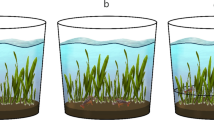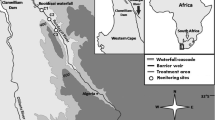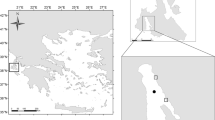Abstract
Macroinvertebrates in aquatic habitats form an integral part of the diet of many freshwater fish. It is therefore important to understand the effects that weed control practices have on this community in canal fishery watercourses. The principal forms of weed control operated in the Grand and Royal Canals include mechanical cutting, using a variety of boat-mounted and land-based apparatus, and chemical treatment using dichlobenil. The community composition and relative abundance of macroinvertebrates in control, mechanically cut and dichlobenil treated canal sites was recorded on three to five occasions between 1993 and 1994. The results indicated that Asellus aquaticus was the dominant organism at all canal locations. The land-based Mowing Bucket effected the greatest reduction in macroinvertebrate numbers in the immediate aftermath of the cut. This reflects the capacity of the machine to cut vegetation to canal bed level, thereby removing any substrate for colonisation. At all eight sites examined, macroinvertebrate numbers increased relatively rapidly following treatment and no adverse effect on dependent fish life resulted. The Office of Public Works policy of removing obstructive vegetation from a central navigation channel, while preserving weeded marginal fringes, minimises the impact of weed control operations on the macroinvertebrate fauna.
Similar content being viewed by others
References
Best, E. P. H., 1981. The submerged aquatic macrophytes in Lake Maarsseveen 1: the species composition, spatial distribution and productivity. Hydrobiol. Bull. 15: 72–81.
Caffrey, J. M., 1988. The status of aquatic plant communities in the Royal and Grand Canals, with reference to past and future weed management programmes. Office of Public Works commissioned report. Central Fisheries Board, Dublin. 107 pp.
Caffrey, J. M., 1990. The classification, ecology and dynamics of aquatic plant communities in some Irish rivers. Ph.D. Thesis, University College, Dublin. 254 pp.
Caffrey, J. M., 1991. Aquatic plants and plant management in the Inchicore area of the Grand Canal. In M. Connaghan, O. Gleeson & A. Maddock (eds), Inchicore and Kilmainham Development Project, Office of Public Works, Dublin: 66–68.
Caffrey, J. M., 1993a. Aquatic weed management practices using dichlobenil: an Irish experience. Pol. Arch. Hydrobiol. 40: 255–266.
Caffrey, J. M., 1993b. Aquatic plant management in relation to Irish recreational fisheries development. J. Aquat. Plant Manage. 31: 162–168.
Caffrey, J. M. & C. Monahan, 1995. Aquatic plant management in Irish canals, 1990–1995. Office of Public Works commissioned report. Central Fisheries Board, Dublin. 102 pp.
Dvorak, J. & P. H. Best, 1982. Macro-invertebrate communites associated with the macrophytes of Lake Vechten: structural and functional relationships. Hydrobiologia 95: 115–126.
Engel, S., 1988. The role and interactions of submersed macrophytes in a shallow Wisconsin lake. J. Freshwat. Ecol. 4: 329–341.
Fox, A. M. & K. J. Murphy, 1990. The efficacy and ecological impacts of herbicide and cutting regimes on the submerged plant communities of four British rivers. I. A comparison of the management efficacies. J. appl. Ecol. 27: 520–540.
Gargan, P. C., 1986. The biology of the fish and faunal communities in Lough Sheelin, Co.Cavan, a eutrophic lake in the Irish midlands. Ph.D. Thesis, University College, Dublin. 367 pp.
Holt, J. & K. Stawn, 1983. Community structure of macrozooplankton in Trinity and Galveston Bays. Estuaries 6: 66–75.
Jenkins, R. A., K. R. Wade & E. Pugh, 1984. Macroinvertebrate habitat relationships in the Teifi catchment and the significance to conservation. Freshwat. Biol. 14: 23–42.
Kennedy, M. & P. Fitmaurice, 1968. The biology of the bream Abramis brama (L.) in Irish waters. Proc. Roy. Ir. Acad. 67B: 95–157.
Kennedy, M. & P. Fitzmaurice, 1970. The biology of the tench Tinch tinca (L.) in Irish waters. Proc. Roy. Ir. Acad. 69B: 31–82.
Kennedy, M. & P. Fitzmaurice, 1974. The biology of the rudd Scardinius erythrophthalmus (L.) in Irish waters. Proc. Roy. Ir. Acad. 74B: 245–303.
Lillie, R. A. & J. Budd, 1992. Habitat architecture of Myriophyllum spicatum L. as an index to habitat quality for fish and macroinvertebrates. J. Freshwat. Ecol. 7: 113–125.
Murphy, K. J. & J. W. Eaton, 1981. Waterplants, boat traffic and angling in canals. Proc. 2nd Brit. Freshwat. Fish. Conf.: 173–187.
Ormerod, S. J., 1988. The micro-distribution of aquatic macroinvertebrates in the Wye River system: the result of abiotic or biotic factors? Freshwat. Biol. 20: 241–247.
Pearson, R. G. & N. V. Jones, 1978. The effects of weed-cutting on the macro-invertebrate fauna of a canalised section of the River Hull, a Northern English chalk stream. J. Envir. Mgmt 7: 91–97.
Rietveld, W. & B. Beltman, 1982. A qualitative analysis of macrofauna sampling in ditches. Hydrobiol. Bull. 16: 149–157.
Rooke, J. B., 1984. The invertebrate fauna of four macrophytes in lotic system. Freshwat. Biol. 14: 507–513.
Scheffer, M., A. A. Achterberg & B. Beltman, 1984. Distribution of macroinvertebrates in a ditch in relation to the vegetation. Freshwat. Biol 14: 367–370.
Weber, C. I., 1973. Biological monitoring of the aquatic environment. Biological methods for the assessment of water quality. American Society for Testing and Materials, 46–60.
Wright, J. F., J. H. Blackburn, D. F. Westlake, M. T. Furse & P. D. Armitage, 1992. Anticipating the consequences of river mangement for the conservation of macroinvertebrates. In P. J. Boon, P. Calow & G. E. Petts (eds), River Conservation and Management, John Wiley and Sons Ltd.: 138–149.
Author information
Authors and Affiliations
Rights and permissions
About this article
Cite this article
Monahan, C., Caffrey, J.M. The effect of weed control practices on macroinvertebrate communities in Irish Canals. Hydrobiologia 340, 205–211 (1996). https://doi.org/10.1007/BF00012756
Issue Date:
DOI: https://doi.org/10.1007/BF00012756




